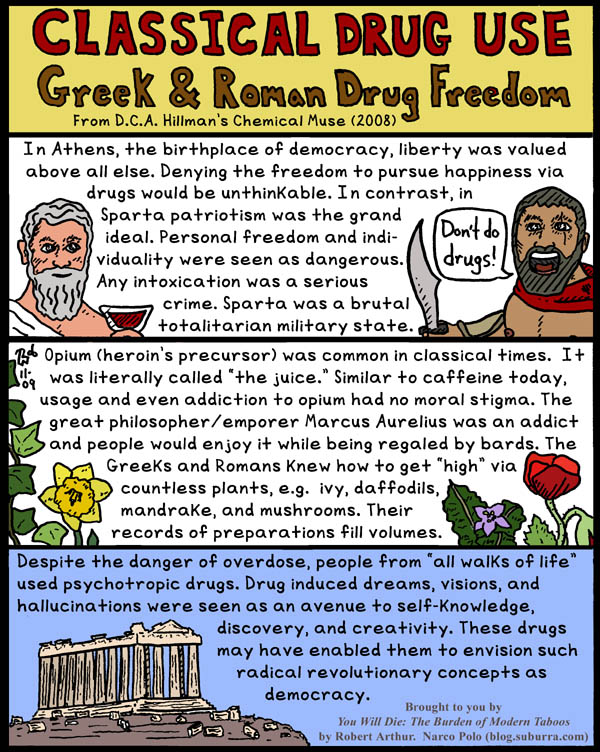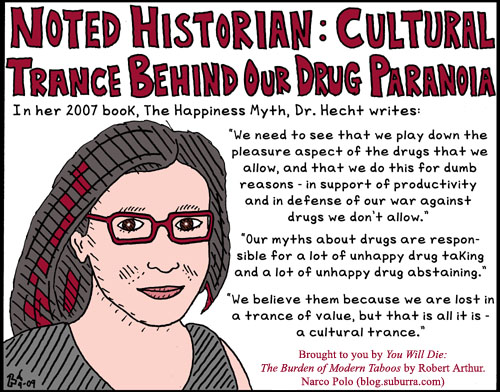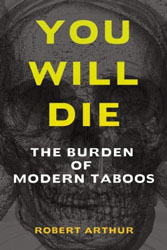Posted: November 16th, 2009 | Filed under: alcohol, drugs, hallucinogens, heroin, history, legalization, mushrooms, opiates | 12 Comments »

As Dr. David Hillman writes in his book, The Chemical Muse (2008):
The Greeks and Romans used opium, anticholinergics, and numerous botanical toxins to induce states of mental euphoria, create hallucinations, and alter their own consciousness; this is an indisputable fact. (p. 87)
This fact has been intentionally ignored and covered up by historians. (See previous post.) Recreational drugs have been translated out of classical literature in the same manner as bawdy sexual references were until recent decades.
This has occurred with individual words. Opium has been translated into poppy seeds even where it makes no sense. But it has also occurred with entire concepts.
Drugs, Sex, Magic
Classical literature abounds with sorcerers, magicians, and witches. Translators rarely reveal that their power stemmed from their great expertise in drugs. Sorcerers were classical drug dealers and the effects of drugs were seen as magical in those times. Drugs and magic were one.
Medea, the wife of Jason the Argonaut, is frequently portrayed as a witch. She aided Jason by putting fire-breathing bulls asleep and giving him amazing courage. Hillman shows how translators mistranslate polypharmakon and pharmaka to present her as being skilled in the “magical arts” and a possessor of “charms.” Medea was actually “drug-savvy” and possessed “drugs.” She gave the bulls and Jason drugs, not spells.
Sorcerers were honored and respected members of society. They and the more run-of-the-mill drug sellers, “root cutters,” had to know how to extract desired chemicals from plants and animals. This was an exact science for the wrong amount or the wrong extraction could kill. For example, mandrake in minute doses could generate euphoria and stimulate libido, at low doses it was an anesthetic, and at regular doses it was lethal.
Symposia and Spiked Wine
The Greeks and Romans favored method of drug administration was to mix them with wine. This has allowed history teachers to present ancient revelers as merely drinkers – not “illegal drug” users. As the scholar, Dr. Carl A.P. Ruck has written:
Ancient wine, like the wine of most early peoples, did not contain alcohol as its sole inebrient but was ordinarily a variable infusion of herbal toxins in a vinous liquid. Unguents, spices, and herbs, all with recognized psychotropic properties, could be added to the wine. (pp. 176-177)
This gives an entirely different purview of the Greek symposia. At these “riotous drinking parties” great minds like Socrates and Plato debated and developed their theories on the great philosophical questions. Another clue tells even more. Altered states of consciousness were viewed as divinely provided madness. Plato wrote:
But he who without divine madness comes to the doors of the Muses, confident that he will be a good poet by art, meets with no success, and the poetry of the sane man vanishes into nothingness before that of the inspired madmen. (p. 177)
To learn about the academic censorship of this scholarship read, “The Ph.D. Candidate Who Said Too Much: A Drug History Whitewash.”
Source:
D.C.A. Hillman, The Chemical Muse: Drug Use and the Roots of Western Civilization (2008). LINK
Posted: September 16th, 2009 | Filed under: cocaine, drugs, history, marijuana, opiates | 2 Comments »

In her popular 2007 book, The Happiness Myth: Why What We Think Is Wrong, historian Jennifer Michael Hecht calls our current demonization of drugs a “cultural trance.” (p. 71) Just like past irrational attitudes the modern view of drugs may eventually reveal itself as, “bossy, shaming, controlling nonsense.” (p. 2)
People follow the conventional wisdom of their era in pursuing happiness. Hecht points out that experts have been proven wrong throughout history and that there is no reason to believe the current batch will fare any better. She reveals numerous “nonsensical cultural assumptions” about drugs, the primary one being that drug induced happiness is inferior to sober happiness. (p. 7)
It wasn’t until the early 20th century that pleasure via drugs was characterized as “naughty.” All cultures have had favorite chemicals to feel better. (The Bible repeatedly advocates using alcohol for joy.) This history has been whitewashed in America. For example, few know that marijuana has been smoked from braziers in Europe since the onset of agriculture roughly 5,000 years ago or that the French Renaissance literary character, the giant Pantagruel, was named after marijuana and smoked it constantly.
Hecht dares to point out that even addiction can be pleasurable. Much of America is addicted to caffeine and looks forward to their “boosts.” They do not suffer because caffeine is freely available. In other cultures and times opiates and cocaine were used in a similarly benign fashion, i.e. laudanum in the West and coca chewing in South America.
Hecht explains how easily our drug attitudes could have been formed differently and how arbitrary our drug categories are. If coca leaves transported easier, chewing may have caught on in Europe and there may have been more resistance to the cocaine prohibitionists. Likewise if caffeine is “chemically goosed” to provide an intense high, caffeine might become a target of the drug war. (p. 92)
In Native American culture there were periodic festivals involving dancing and the closely supervised administration of drugs which brought about spiritual revelation and euphoria. Teenagers participated. A longing for these experiences still exists as, “many people, especially young people, say they are never happier than when they are a little high and listening to live music, or dancing.” (p. 118) However, in current American culture this behavior has been criminalized due to our “pharmacological Calvinism” so young adults who persist must get their substances from the black market and consume them without supervision. (p. 119)
Hecht lists circumstances in which she suggests one consider using drugs. Some of them are:
1. If you long for a break from your “symptoms” or merely from your personality.
2. If you want to know more about the nature of reality and how the mind creates it.
3. If you want to have an intense communing experience with someone.
4. If you want to have a good time on a given evening.
5. If you want to dance and be social, but you are too inhibited.
Hecht cautions people against using illegal drugs in the current environment and recognizes their dangers. However, she writes that life is full of risky behaviors, e.g. driving cars, mountain climbing, living a sedentary life. The risks and benefits are balanced when deciding whether to regulate or criminalize these activities, but with drugs modern policy makers completely discount the happiness that drugs bring.
Modern pundits who claim we are dosing ourselves too freely are not speaking with historical knowledge or philosophical sense. Keeping your mind in only one place is not a very assertive way to relate to life, to search it for happiness, or for truth. (p. 127)
The Happiness Myth: Why What We Think Is Wrong also covers false cultural assumptions in the areas of wisdom, money, bodies, and celebration.
Posted: July 15th, 2009 | Filed under: alcohol, DEA, drugs, heroin, history, opiates | 4 Comments »

In 1973 President Richard Nixon created the Drug Enforcement Administration (DEA) claiming there was a junkie explosion with eight times as many heroin addicts as two years earlier (a lie), and that drugs were “decimating a generation of Americans.” At the time, far more Americans were dying from choking on food or falling down stairs. (Baum, pp. 12, 28)
In reality, Nixon saw the DEA as a jurisdiction-free police force that would indirectly target blacks saying, “You have to face the fact that the whole problem is really the blacks. The key is to devise a system that recognizes this all while not appearing to.” (Baum, p. 13)
An assistant to Egil Krogh, a member of Nixon’s administration imprisoned in the Watergate scandal, explained, “If we hyped the drug problem into a national crisis, we knew that Congress would give us anything we asked for.” (Epstein, p. 140)
While president, Nixon would get drunk and pop pills from his private stash. He never had himself arrested.
Nixon’s statistical deceit regarding heroin addict numbers is explained in Agency of Fear: Opiates and Political Power in America. (pp. 174-177) When Nixon later wanted to show his War on Drugs was working the addict population was magically sliced by 25%.
The Nixon quotes are from Dan Baum’s Smoke and Mirrors: The War on Drugs and the Politics of Failure. Baum took the “blacks” quote from the diary of Nixon’s Chief of Staff, H.R. Haldeman. Another quote in Haldeman’s diary was that Nixon wanted to know “why all the Jews seem to be the ones that are for liberalizing the regulations on marijuana.” (p. 54)
Nixon’s generous use of drugs – prescribed and not prescribed (Dilantin) – and alcohol is detailed in Anthony Summers’ The Arrogance of Power: The Secret World of Richard Nixon.
* This post was updated on May 30, 2012.
Sources:
1. Robert Arthur, You Will Die: The Burden of Modern Taboos (2008).
2. Dan Baum, Smoke and Mirrors: The War on Drugs and the Politics of Failure (1996).
3. Edward Jay Epstein, Agency of Fear: Opiates and Political Power in America (1977).
4. Anthony Summers, The Arrogance of Power: The Secret World of Richard Nixon (2000).





